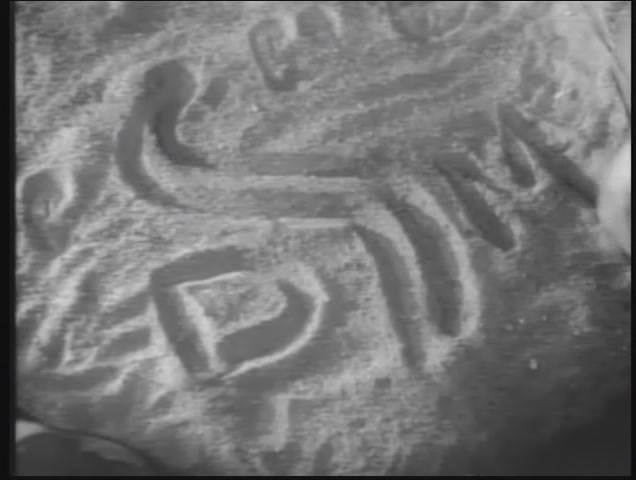THE American WESTERN
By Jeffrey-Baptiste Tarlofsky
By Jeffrey-Baptiste Tarlofsky
Lesson 11 consists of four video lectures and transcripts of those lectures, and four film excerpts. Start with excerpt #1 from Red River and continue down the page in sequence until you reach the end of the lesson.
レッスン11は4本のビデオレクチャー(レクチャーのテキストがビデオレクチャーの下に記載されています)と4 本の動画で構成されています。
このレッスンは、ページをスクロールダウンしながら最初から順番に動画を見たりテキストを読んでください。

Directed & produced by: Howard Hawks
Screen play by: Borden Chase
Starring: John Wayne, Montgomery Clift, Walter Brennan, Joanne Dru
Music by: Dimitri Tiomkin
Distributed by: United Artists
Running time: 133 minutes (Pre-release) 127 minutes (Theatrical)
Budget: $2.7 million
Box office: $9,012,000
Part 1 – One old joke goes that all Hollywood movies have the same basic story: Boy meets girl, boy and girl fall in love, boy loses girl, boys finds girl again, the end. Stagecoach follows this pattern. Ringo meets Dallas, Ringo and Dallas fall in love, Ringo leaves Dallas to face hopeless odds against the Plummer brothers, Ringo returns victorious to claim Dallas as his bride, the end. Red River is almost the exact inverse of this pattern. The film starts with Tom losing his girl, but he never gets her back. Instead, Matt meets a different girl in almost the same situation (an attack on a wagon train by the Comanche) in which Tom lost his girl. Matt, not Tom, “finds the girl”. It was an interesting idea to have Matt have the relationship Tom never did, but Howard Hawkes failed to make the idea work. Instead it just distracts us from the main part of the story, which is about the relationship between Tom and Matt and the historic cattle drive. The idea might have worked better if Tess were a better written character and Hawkes had given better direction to Joanne Dru who was the actress playing Tess.
Unfortunately, from the moment Tess appears, the film has problems. Don’t take my word for it. Here are the words of America’s most popular and important film critic of recent times, Roger Ebert: “Red River is one of the greatest of all Westerns when it stays with its central story about an older man and a younger one, and the first cattle drive down the Chisholm Trail. It is only in its few scenes involving women that it goes wrong.”
But how can Howard Hawkes have created a failed woman character when he was famous for creating the “Hawkesian woman” who “gets what she wants personally as well as sexually.” That may be just the problem. Contrast Tess Millay with Stagecoach’s Dallas for a moment. Dallas, as we know, was a prostitute. But at no time in John Ford’s film did Dallas ever act in a sexually aggressive way. Dallas is a prostitute because it was the only way she could survive as a young girl alone in the West of the 1880s after her family were all killed in an Indian massacre. When Dallas and Ringo fall in love it is not because they are sexually attracted to one another, it is because they have both experienced the trauma of losing their families to violence. Both are survivors and they know what it takes to survive. Dallas says “Well, you have to live” and Ringo answers “That’s it”. On the other hand, Tess and Matt’s attraction to each other is purely sexual. There is certainly nothing wrong with sexual attraction, but the result is that we in the audience never develop the same sympathy for Tess and Matt that we have for Dallas and Ringo.
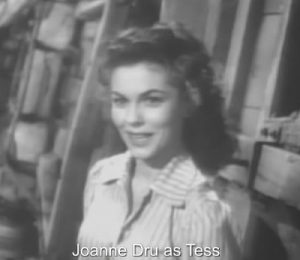
Trail boss taking a break from the cattle drive.
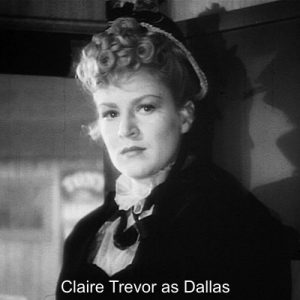
The cattle drive formation.
In Dallas, John Ford created one of the greatest woman characters in Western film…one who was literally the model for many others to follow; the “prostitute with the heart of gold”. Tess Millay is nothing like Dallas. She may be a “Hawkesian woman”, but Roger Ebert says of Tess, “The three scenes with Tess are the movie’s low points, in part because of her prattle (listen to how she chats distractingly with Matt during an Indian attack)”. Her talk is supposed to be an example of a Hawkesian woman being clever, but this “cleverness” gets her shot by an arrow. After Matt pulls the arrow out, she slaps him because it was something she had” been wanting to do for a while”, but later she asks Cherry “Why did I do that, Cherry?” Doesn’t she know why she does things? This doesn’t make her an interesting or deep character like Dallas, it makes her seem scatterbrained and willful.
In Stagecoach, Ringo tells Dallas he has a small ranch and that the two of them could live there together. It will be hard work, but Ringo wants Dallas to go with him and share his work. But in Hawkes’ Red River Tom tells his fiancé that he is going to start a ranch but that the work is “too much for a woman”. Instead of answering that she can do the work, she tells Tom that he “will need what a woman can give. The sun only shines half the day…”. In other words, he should take her along not because she can share the work, but because she can give him sex. When Ringo thinks he is going back to prison he asks Curly to take Dallas to his ranch so she can wait for him there. He obviously believes she can survive on the ranch all alone. In other words, he gives her credit for being a strong, independent woman. But when Groot suggests taking Tess on the cattle drive, Matt rejects the idea as impossible. Why? It seems that despite his creation of the “Hawkesian woman”, Howard Hawkes didn’t think women could be as strong and independent as John Ford thought they could be.
Howard Hawkes tried very hard to make the scene between Dunson and Tess work, but too much of it is just more of his “Hawkesian woman” stuff. Tess smokes, deals cards, drinks whiskey, hides a gun in her sling, but none of it seems genuine, especially after Dunson gets the weird idea of asking her to have a child for him.
He tells her to “stand up, turn around” as if he were buying a horse. She quite rightly replies “don’t tell me what to do!” But then Hawkes spoils the moment by having her do just what Dunson told her to do! She stands up and turns around showing herself to Dunson as if…well, as if she were a prostitute. Can you imagine Dallas doing any of this nonsense?
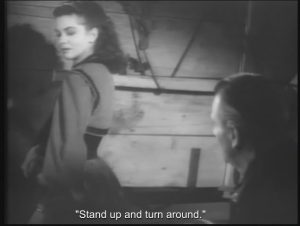
The one part of this scene which does work, in my opinion, is when Tom notices that Tess now has the bracelet. He asks her “How did you get that away from him? “and she replies “I stole it”. That is actually a cleverly ironic way of telling Dunson that she didn’t steal it, but that Matt gave it to her because they have become lovers. This is also the scene where Hawkes tries his best to draw a parallel between Tom and his fiancé and Matt and Tess. It seems clumsy and manipulative. A director can certainly manipulate his audience, but the audience doesn’t like to know they are being manipulated.
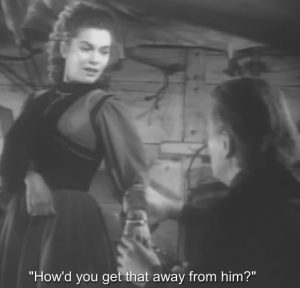
Part 3 – So, it turns out that Matt and the others were right to follow the Chisholm trail to Kansas. They have brought the herd to market and Matt has concluded a deal for the whole herd which will pay Dunson $23.00 per head. They have about 10,000 head of cattle which means Dunson will receive $230,000.00 for his herd. Each cowboy who drove the cattle for him will receive just about exactly $100.00. For your homework tonight you will read about this, but before you do take a moment and think about it. What is your reaction to those numbers?
Part 4 – The ending of Red River strikes different people in different ways. Some people think it is a success, but many more think it is a failure. You are certainly allowed to have your own opinion about it. However, whether you think it is a success or not, you must admit that it is both surprising and totally inconsistent with the rest of the film. Roger Ebert said, “The final scene is the weakest in the film, and Borden Chase reportedly hated it, with good reason: Two men act out a fierce psychological rivalry for two hours, only to cave in instantly to a female’s glib tongue-lashing.”
Borden Chase’s original ending in the novel, Blazing Guns Along the Chisholm Trail, has Dunson killing Cherry in their gunfight, but being so badly wounded himself that when he finally gets to Matt, he can barely raise his gun and when he fires, he only wounds Matt slightly before collapsing. Then Matt and Tess take the wounded Dunson south to die in his beloved Texas. In other words, Chase’s novel has a sad and tragic ending instead of the comical and happy one Howard Hawkes uses. I think Hawke’s ending is actually a reflection of the shift in the meaning of the story he brought to the film. The novel was a much darker story in which neither Dunson nor Matt are very likable characters. Neither are Cherry or Tess for that matter. The film made all of them more likable, but it also completely changed the relationships between the three male characters. It especially changed the relationship between Tom and Matt.
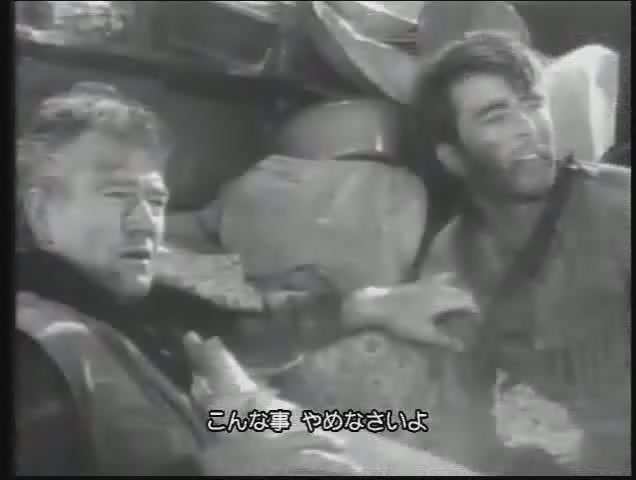
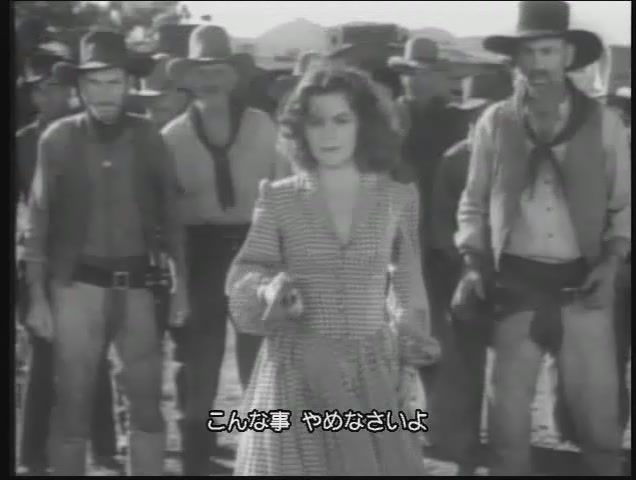
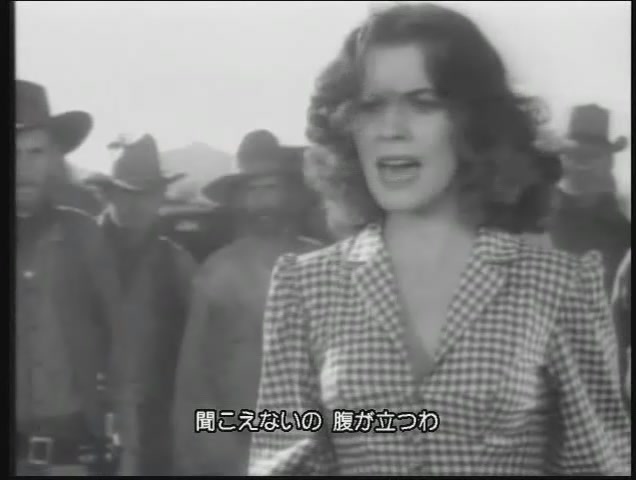
For your homework in lesson 12 you read that the “obvious interpretation” of the relationship between Tom and Matt is that they are like father and son. But we have to remember that Tom and Matt are not really father and son. Their relationship is like a father and son relationship in many ways, but it is also something else. In Stagecoach, the open secret of the film was that the main female character, Dallas, is a prostitute. In Red River, the less obvious secret is that Tom and Matt are (or were previously) lovers (koibito). However, in the America of 1948, very few straight (heterosexual) people were able (or willing) to see this. But Everyone who was LGBTQ saw it. That is because in 1948 LGBTQ people had to hide themselves because our relationships were still largely illegal. So, America in 1948 was a terrible place to be an LGBTQ person. However, the American West of 1866 was not so bad. At least it was not such a bad place to be a gay man, or more precisely, a man who had sexual and/or romantic relationships with other men. This was especially true of the cowboys. This shouldn’t surprise you. The cowboys and their way of life was very similar to the samurai culture of Japan and same sex relationships between the samurai were very common.
Comparing the samurai world with the cowboy world can help us understand why male-male relationships were so common in the American West. Samurai and cowboys both lived in almost completely male worlds where there were few women or women lived separate and very different lives from the men. Being a samurai or cowboy required intense physical work and close cooperation between the men. Practical skills such as swordsmanship and the use of firearms were passed from older men to younger men at an early age. Both the samurai and cowboys began their training at about the age of twelve or even younger. For these reasons and others both the samurai and the cowboys frequently had intense male-male friendships that often became romantic and/or sexual relationships. Sometimes this was simply because there were so few women available for the men to have relationships with, but often it was because the men preferred to be with other men or boys with whom they shared the same interests. Sometimes two friends of the same age became lovers, but in many cases the relationships were between men of different ages. The more experienced man took on the role of mentor and the younger one learned how to behave from his mentor. Tom was about forty when he met Matt and Matt was fourteen. They are like father and son, but they are (or were) lovers. That is my interpretation of the film.
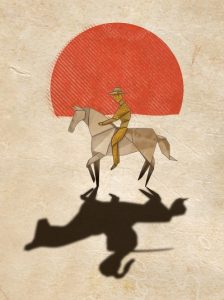
But how can “gay” men also have relationships with women as both Tom and Matt do? Well, that word “gay” and the ideas it represents didn’t exist in those times. Many men were bisexual. Among the samurai, the mentor might already be married and have children of his own while still being the mentor of a younger man who was also his lover.
In Red River, the first time we see Tom he is with the only woman he will ever love. He expressed that love for her by giving her his mother’s bracelet. But it is that same bracelet he gives to his male lover with whom he has had a relationship for more than fourteen years. Look at both scenes again.
Part 5 – I told you to keep your eyes on that bracelet. It is now clear that the bracelet is passed from lover to lover three times in the film: from Tom to the girl he loves, from Tom to the boy he loves, and finally from Matt to the girl he loves. By the way, this was something Howard Hawkes added to the story. There is no bracelet in the novel.
By the time Matt has returned from the Civil War, he and Tom have probably not seen each other for three or four years, and they are probably no longer physical lovers. But Matt still wears Toms bracelet. One of the things about male-male relationships is that they often start as friendships, go through a sexual phase and then once again become friendships. In both samurai and cowboy culture, male lovers were often best friends for life even if they were no longer involved sexually. This is why Matt can give the bracelet to Tess. He and Tom are no longer romantically or sexually lovers. Is this strange? Not at all. In samurai culture, for example, an older male lover might be expected to teach his younger male lover lessons about women. The older lover might even help his younger friend’s family choose an appropriate wife for the younger man. That is actually what happens at the end of Red River. Tom tells Matt, “I think you better marry that girl, Matt”.
Hawkes also radically changed the character of Cherry Valance. In the novel, Cherry was Matt’s rival for Tess, but in the film, Cherry is much more romantically and sexually interested in Matt! They are a lot alike; young, handsome, self-confident, fast with a gun. But Cherry’s interest in Matt is not just about their rivalry as gunslingers. Watch the scene between the two of them again.
Part 6 – Cherry is flirting with Matt shamelessly. The question about the Swiss watch is obviously really about women; “Matt, have you ever been with a woman… or just Tom?” Later, Cherry explains that the reason he came on the drive is because Matt told him he couldn’t. This is a flirtation game that young people play called “hard to get”. Cherry also openly admits that he hopes to get Matt’s gun! A man’s gun in the West is his most personal possession, like the sword of a samurai. To say you want a man’s gun is almost like saying you want the man himself. I don’t think I have to tell you that both guns and swords are among the most obvious of all phallic symbols in literature or film.
How did Red River get away with all this when homosexual relationships were against the very strict censorship rules in Hollywood at the time? Howard Hawkes managed this the same way John Ford managed to include a prostitute as one of his main characters in Stagecoach: by showing, but not telling. Hawkes was greatly helped by the fact that most straight people in 1948, including the Hollywood censors, simply did not understand same sex relationships. What was obvious to every LGBTQ person in the audience, was invisible to the non-LGBTQ people.
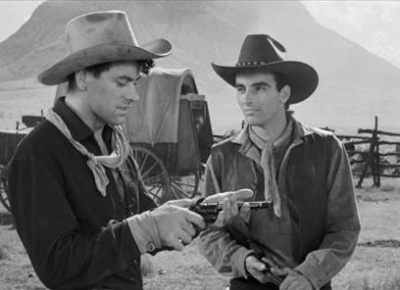
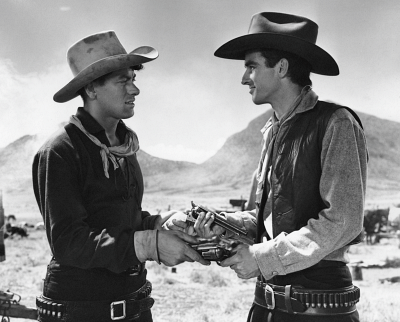
Some of the hints Hawkes included were downright outrageous.
When Matt jokes, “You’re going to brand every rump in the state of Texas except mine!”,
Tom jokes right back, “Teller, give me that branding iron! You don’t think I would?”
Matt never seems more like a little boy than when he almost giggles and says, “No, (giggle), I don’t”.
It’s a joke, but it is a joke only two lovers would share.
They say this openly in front of all the other cowboys, but none of the other cowboys find this strange or comment about it. They would all know Tom and Matt had been lovers and nobody would think that was strange. Besides, who is going to make a homophobic remark to Tom or Matt when they are the two most dangerous gunslingers in Texas? And who would say anything to Cherry about flirting with Matt when he is the third most dangerous gunslinger in Texas? Good luck staying alive if you do.
Let me take this even a step further and say that the real love triangle in the film is entirely homosexual. Tom and Cherry both love Matt. Cherry shoots Tom’s hand precisely because he knows that Tom is Matt’s old lover and Matt will never shoot his old lover. Cherry also attempts to protect Matt in the final confrontation, but Dunson is faster (and may have killed Cherry. We never learn what happened to Cherry).
But the one person who really understands what is going on between Tom and Matt is Tess. Tess may be the least successful character in the film, but she is much more likable in the film than she was in the book. In the book, Tess manipulates men into killing each other so she gets what she wants. In the film, Tess may be annoying, but she is definitely a good person. She is also the one who best understands what is going on between Tom and Matt. Even when she is making love to Matt in the rain she says “You love him (Tom), don’t you? He must love you. That wouldn’t be hard.”.
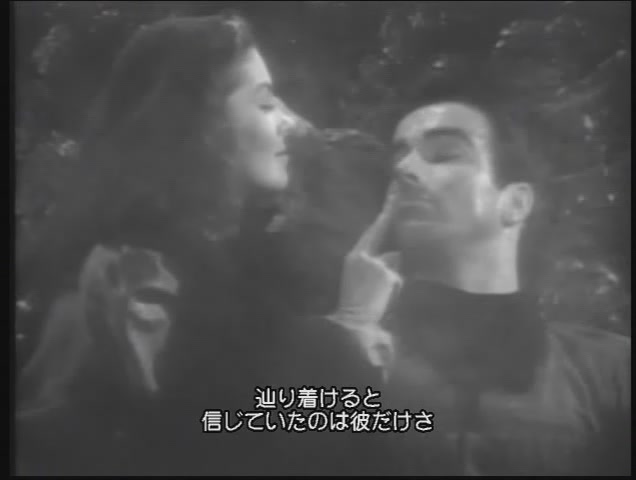
Part 7
Tess certainly wants Matt for herself, but she understands that the two men have this deep love for each other and she does not see Tom as her rival. Like Cherry, who also loves Matt, she understands the intensity of Matt and Tom’s relationship and, like Cherry, she knows that Matt could never shoot Tom. But Tess is also the first one to understand that Tom could never shoot Matt. This is why she stops them from fighting at the end of the film. That ending may seem silly, but Tess is exactly right when she says, “Stop it! It’s obvious to everyone that you two love each other”. Actually, it wasn’t obvious to everyone, (like the people in the movie theater watching the film) but it was obvious to her and it was obvious to Howard Hawkes and it was obvious to everyone who was LGBTQ. It is when Tess acknowledges that the two men love each other that Tom in turn acknowledges that Matt loves her and tells him to marry her. However, the last thing you see in the film is Tom changing the brand from just a “Red River D” to a “Red River D and M”. Tom is telling Matt, “Even though you are marrying that girl, you and I will be best friends forever”.
Everyone respects everyone’s right to love whom they please at the end of the film. Maybe it was a good ending, after all.
We are at long last finished with this gigantic movie. This concludes Lesson 13.
